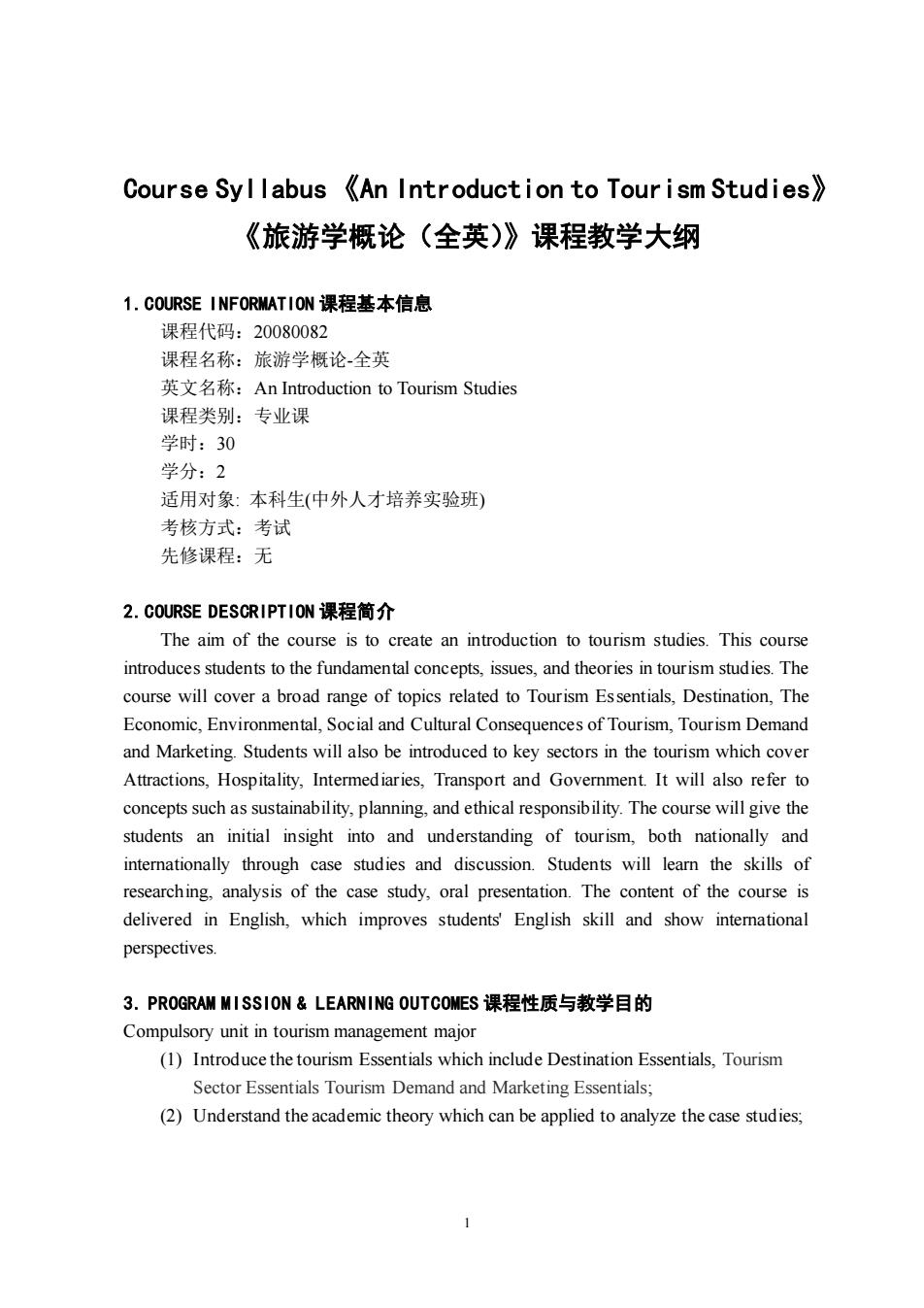
Course Syl labus An Introduction to Tour ism Studies 《旅游学概论(全英)》课程教学大纲 1.COURSE INFORMATION课程基本信息 课程代码:20080082 课程名称:旅游学概论全英 英文名称:An Introduction to Tourism Studies 课程类别:专业课 学时:30 学分:2 适用对象:本科生(中外人才培养实验班) 考核方式:考试 先修课程:无 2.COURSE DESCRIPTION课程简介 The aim of the course is to create an introduction to tourism studies.This course introduces students to the fundamental concepts,issues,and theories in tourism studies.The course will cover a broad range of topics related to Tourism Essentials,Destination,The Economic,Environmental,Social and Cultural Consequences of Tourism,Tourism Demand and Marketing.Students will also be introduced to key sectors in the tourism which cover Attractions,Hospitality,Intermediaries,Transport and Government.It will also refer to concepts such as sustainability,planning,and ethical responsibility.The course will give the students an initial insight into and understanding of tourism,both nationally and internationally through case studies and discussion.Students will learn the skills of researching.analysis of the case study,oral presentation.The content of the course is delivered in English,which improves students English skill and show intemational perspectives. 3.PROGRAM MISSION&LEARNING OUTCOMES课程性质与教学目的 Compulsory unit in tourism management major (1)Introduce the tourism Essentials which include Destination Essentials,Tourism Sector Essentials Tourism Demand and Marketing Essentials; (2)Understand the academic theory which can be applied to analyze the case studies
1 Course Syllabus 《An Introduction to Tourism Studies》 《旅游学概论(全英)》课程教学大纲 1.COURSE INFORMATION 课程基本信息 课程代码:20080082 课程名称:旅游学概论-全英 英文名称:An Introduction to Tourism Studies 课程类别:专业课 学时:30 学分:2 适用对象: 本科生(中外人才培养实验班) 考核方式:考试 先修课程:无 2.COURSE DESCRIPTION 课程简介 The aim of the course is to create an introduction to tourism studies. This course introduces students to the fundamental concepts, issues, and theories in tourism studies. The course will cover a broad range of topics related to Tourism Essentials, Destination, The Economic, Environmental, Social and Cultural Consequences of Tourism, Tourism Demand and Marketing. Students will also be introduced to key sectors in the tourism which cover Attractions, Hospitality, Intermediaries, Transport and Government. It will also refer to concepts such as sustainability, planning, and ethical responsibility. The course will give the students an initial insight into and understanding of tourism, both nationally and internationally through case studies and discussion. Students will learn the skills of researching, analysis of the case study, oral presentation. The content of the course is delivered in English, which improves students' English skill and show international perspectives. 3. PROGRAM MISSION & LEARNING OUTCOMES 课程性质与教学目的 Compulsory unit in tourism management major (1) Introduce the tourism Essentials which include Destination Essentials, Tourism Sector Essentials Tourism Demand and Marketing Essentials; (2) Understand the academic theory which can be applied to analyze the case studies;
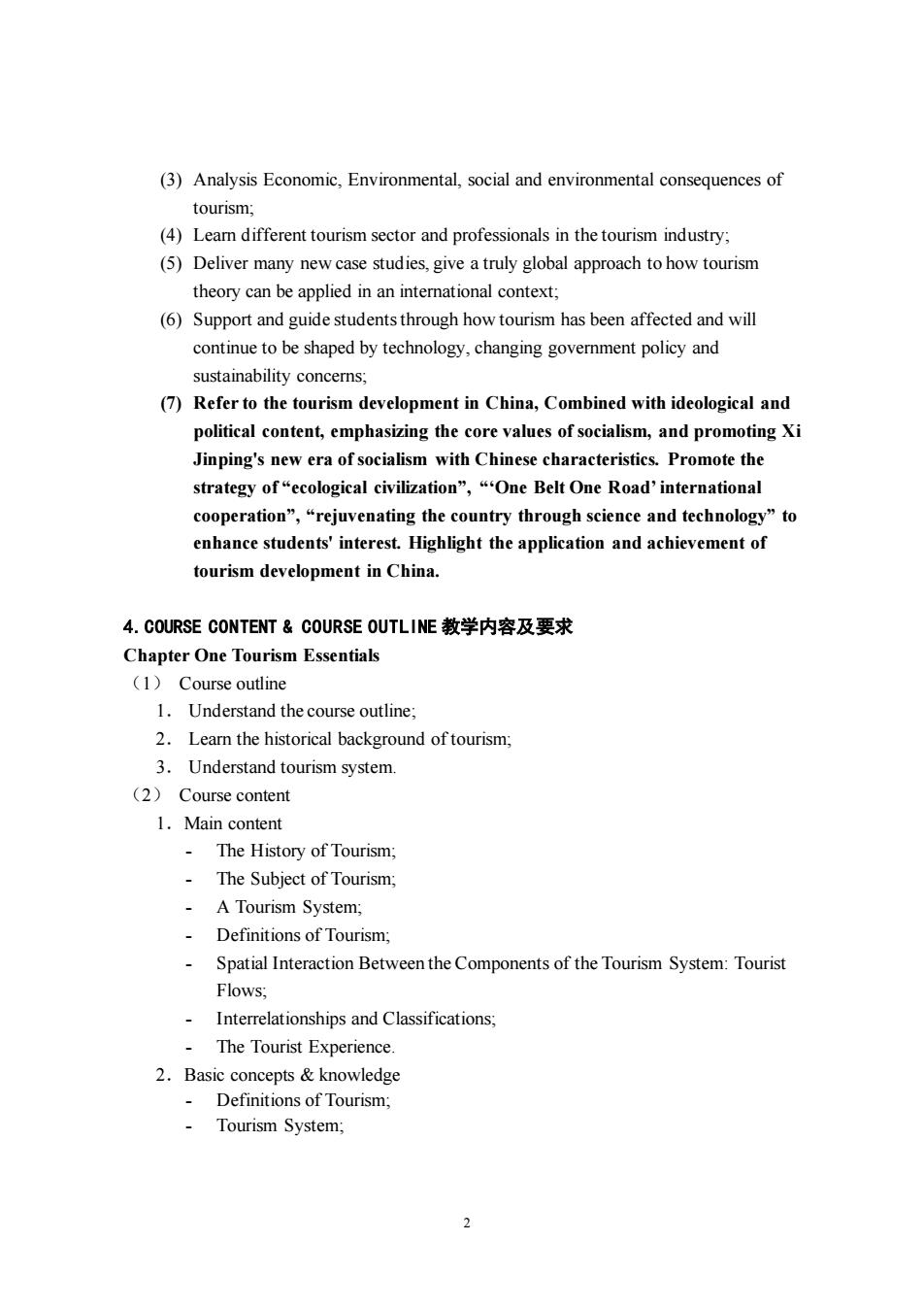
(3)Analysis Economic,Environmental,social and environmental consequences of tourism, (4)Leam different tourism sector and professionals in the tourism industry; (5)Deliver many new case studies.give a truly global approach to how tourism theory can be applied in an international context; (6)Support and guide students through how tourism has been affected and will continue to be shaped by technology.changing government policy and sustainability concerns; (7)Refer to the tourism development in China,Combined with ideological and political content,emphasizing the core values of socialism,and promoting Xi Jinping's new era of socialism with Chinese characteristics.Promote the strategy of"ecological civilization","One Belt One Road'international cooperation","rejuvenating the country through science and technology"to enhance students'interest.Highlight the application and achievement of tourism development in China 4.COURSE CONTENT&COURSE OUTLINE教学内容及要求 Chapter One Tourism Essentials (1)Course outline 1.Understand the course outline: 2.Leamn the historical background of tourism 3.Understand tourism system. (2)Course content 1.Main content The History of Tourism 、 The Subject of Tourism A Tourism System Definitions of Tourism: Spatial Interaction Between the Components of the Tourism System:Tourist Flows: Interrelationships and Classifications; The Tourist Experience. 2.Basic concepts&knowledge -Definitions of Tourism; Tourism System;
2 (3) Analysis Economic, Environmental, social and environmental consequences of tourism; (4) Learn different tourism sector and professionals in the tourism industry; (5) Deliver many new case studies, give a truly global approach to how tourism theory can be applied in an international context; (6) Support and guide students through how tourism has been affected and will continue to be shaped by technology, changing government policy and sustainability concerns; (7) Refer to the tourism development in China, Combined with ideological and political content, emphasizing the core values of socialism, and promoting Xi Jinping's new era of socialism with Chinese characteristics. Promote the strategy of “ecological civilization”, “‘One Belt One Road’ international cooperation”, “rejuvenating the country through science and technology” to enhance students' interest. Highlight the application and achievement of tourism development in China. 4.COURSE CONTENT & COURSE OUTLINE 教学内容及要求 Chapter One Tourism Essentials (1) Course outline 1. Understand the course outline; 2. Learn the historical background of tourism; 3. Understand tourism system. (2) Course content 1.Main content - The History of Tourism; - The Subject of Tourism; - A Tourism System; - Definitions of Tourism; - Spatial Interaction Between the Components of the Tourism System: Tourist Flows; - Interrelationships and Classifications; - The Tourist Experience. 2.Basic concepts & knowledge - Definitions of Tourism; - Tourism System;
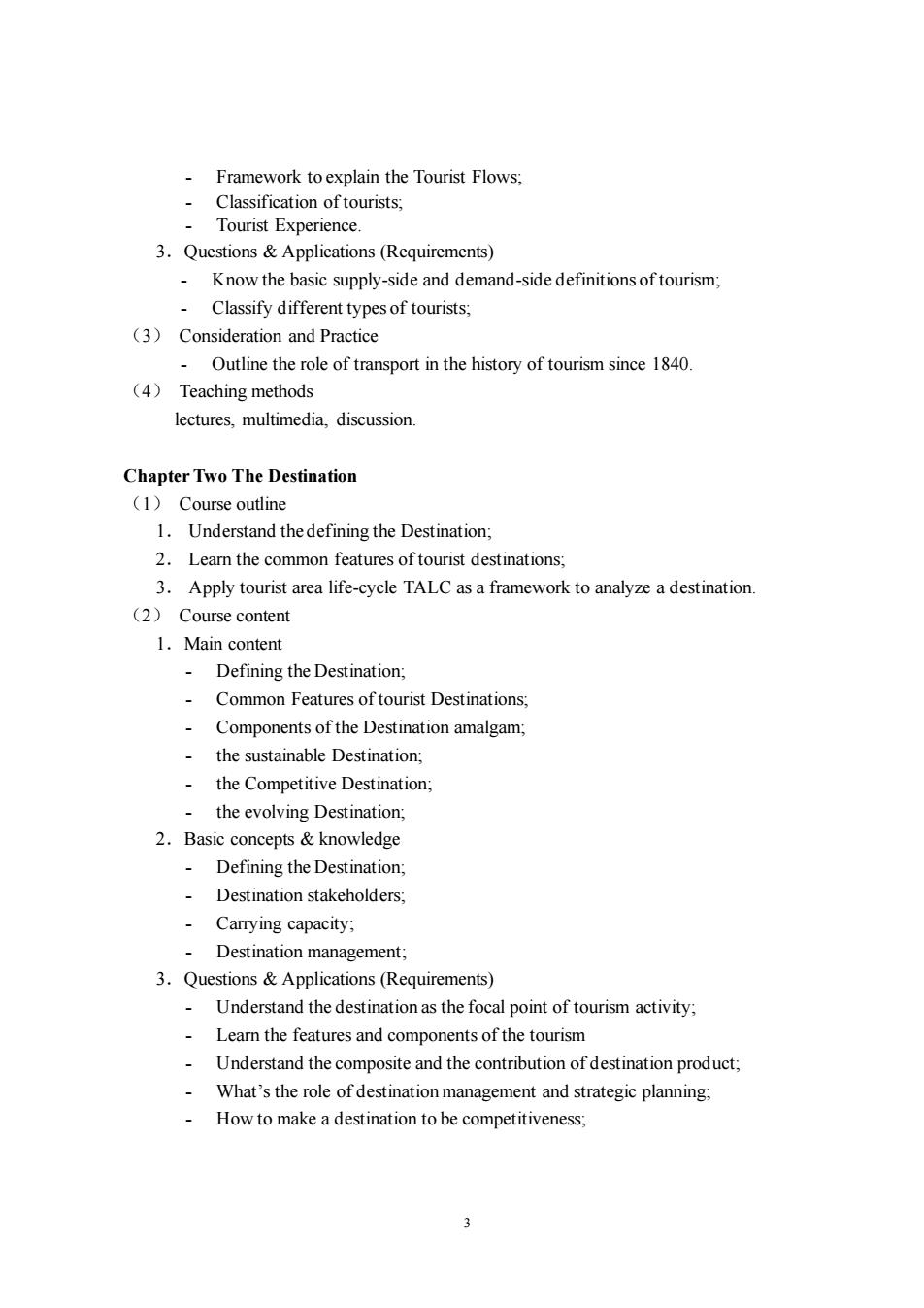
Framework to explain the Tourist Flows, -Classification of tourists: Tourist Experience. 3.Questions&Applications(Requirements) -Know the basic supply-side and demand-side definitions of tourism. Classify different types of tourists; (3)Consideration and Practice Outline the role of transport in the history of tourism since 1840. (4)Teaching methods lectures,multimedia,discussion. Chapter Two The Destination (1)Course outline 1.Understand the defining the Destination; 2.Leamn the common features oftourist destinations. 3.Apply tourist area life-cycle TALC as a framework to analyze a destination. (2)Course content 1.Main content Defining the Destination; Common Features of tourist Destinations: Components of the Destination amalgam the sustainable Destination: the Competitive Destination the evolving Destination: 2.Basic concepts&knowledge Defining the Destination: Destination stakeholders: Carrying capacity: Destination management: 3.Questions Applications(Requirements) Understand the destination as the focal point of tourism activity; Leam the features and components of the tourism Understand the composite and the contribution of destination product: What's the role of destination management and strategic planning How to make a destination to be competitiveness; 3
3 - Framework to explain the Tourist Flows; - Classification of tourists; - Tourist Experience. 3.Questions & Applications (Requirements) - Know the basic supply-side and demand-side definitions of tourism; - Classify different types of tourists; (3) Consideration and Practice - Outline the role of transport in the history of tourism since 1840. (4) Teaching methods lectures, multimedia, discussion. Chapter Two The Destination (1) Course outline 1. Understand the defining the Destination; 2. Learn the common features of tourist destinations; 3. Apply tourist area life-cycle TALC as a framework to analyze a destination. (2) Course content 1.Main content - Defining the Destination; - Common Features of tourist Destinations; - Components of the Destination amalgam; - the sustainable Destination; - the Competitive Destination; - the evolving Destination; 2.Basic concepts & knowledge - Defining the Destination; - Destination stakeholders; - Carrying capacity; - Destination management; 3.Questions & Applications (Requirements) - Understand the destination as the focal point of tourism activity; - Learn the features and components of the tourism - Understand the composite and the contribution of destination product; - What’s the role of destination management and strategic planning; - How to make a destination to be competitiveness;
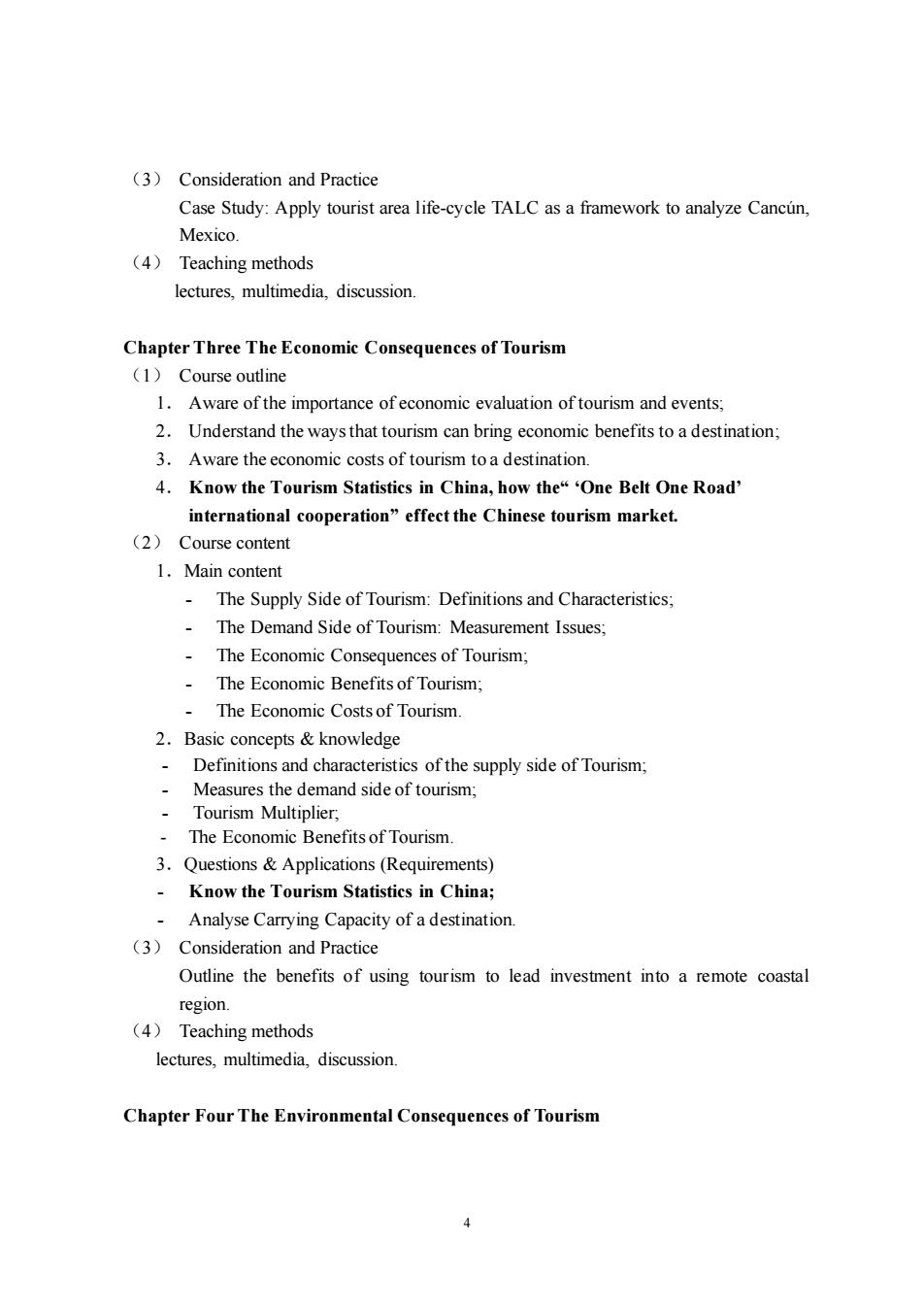
(3)Consideration and Practice Case Study:Apply tourist area life-cycle TALC as a framework to analyze Cancun, Mexico. (4)Teaching methods lectures.multimedia.discussion Chapter Three The Economic Consequences of Tourism (1)Course outline 1.Aware of the importance ofeconomic evaluation of tourism and events, 2.Understand the ways that tourism can bring economic benefits to a destination; 3.Aware the economic costs of tourism toa destination. 4.Know the Tourism Statistics in China.how the"One Belt One Road international cooperation"effect the Chinese tourism market. (2)Course content 1.Main content The Supply Side of Tourism:Definitions and Characteristics; The Demand Side of Tourism:Measurement Issues; The Economic Consequences of Tourism; The Economic Benefits of Tourism The Economic Costs of Tourism. 2.Basic concepts&knowledge Definitions and characteristics of the supply side of Tourism; 、 Measures the demand side of tourism; Tourism Multiplier. The Economic Benefits of Tourism 3.Questions Applications (Requirements) -Know the Tourism Statistics in China: Analyse Carrying Capacity of a destination. (3)Consideration and Practice Outline the benefits of using tourism to lead investment into a remote coastal region. (4)Teaching methods lectures,multimedia,discussion Chapter Four The Environmental Consequences of Tourism 4
4 (3) Consideration and Practice Case Study: Apply tourist area life-cycle TALC as a framework to analyze Cancún, Mexico. (4) Teaching methods lectures, multimedia, discussion. Chapter Three The Economic Consequences of Tourism (1) Course outline 1. Aware of the importance of economic evaluation of tourism and events; 2. Understand the ways that tourism can bring economic benefits to a destination; 3. Aware the economic costs of tourism to a destination. 4. Know the Tourism Statistics in China, how the“ ‘One Belt One Road’ international cooperation” effect the Chinese tourism market. (2) Course content 1.Main content - The Supply Side of Tourism: Definitions and Characteristics; - The Demand Side of Tourism: Measurement Issues; - The Economic Consequences of Tourism; - The Economic Benefits of Tourism; - The Economic Costs of Tourism. 2.Basic concepts & knowledge - Definitions and characteristics of the supply side of Tourism; - Measures the demand side of tourism; - Tourism Multiplier; - The Economic Benefits of Tourism. 3.Questions & Applications (Requirements) - Know the Tourism Statistics in China; - Analyse Carrying Capacity of a destination. (3) Consideration and Practice Outline the benefits of using tourism to lead investment into a remote coastal region. (4) Teaching methods lectures, multimedia, discussion. Chapter Four The Environmental Consequences of Tourism
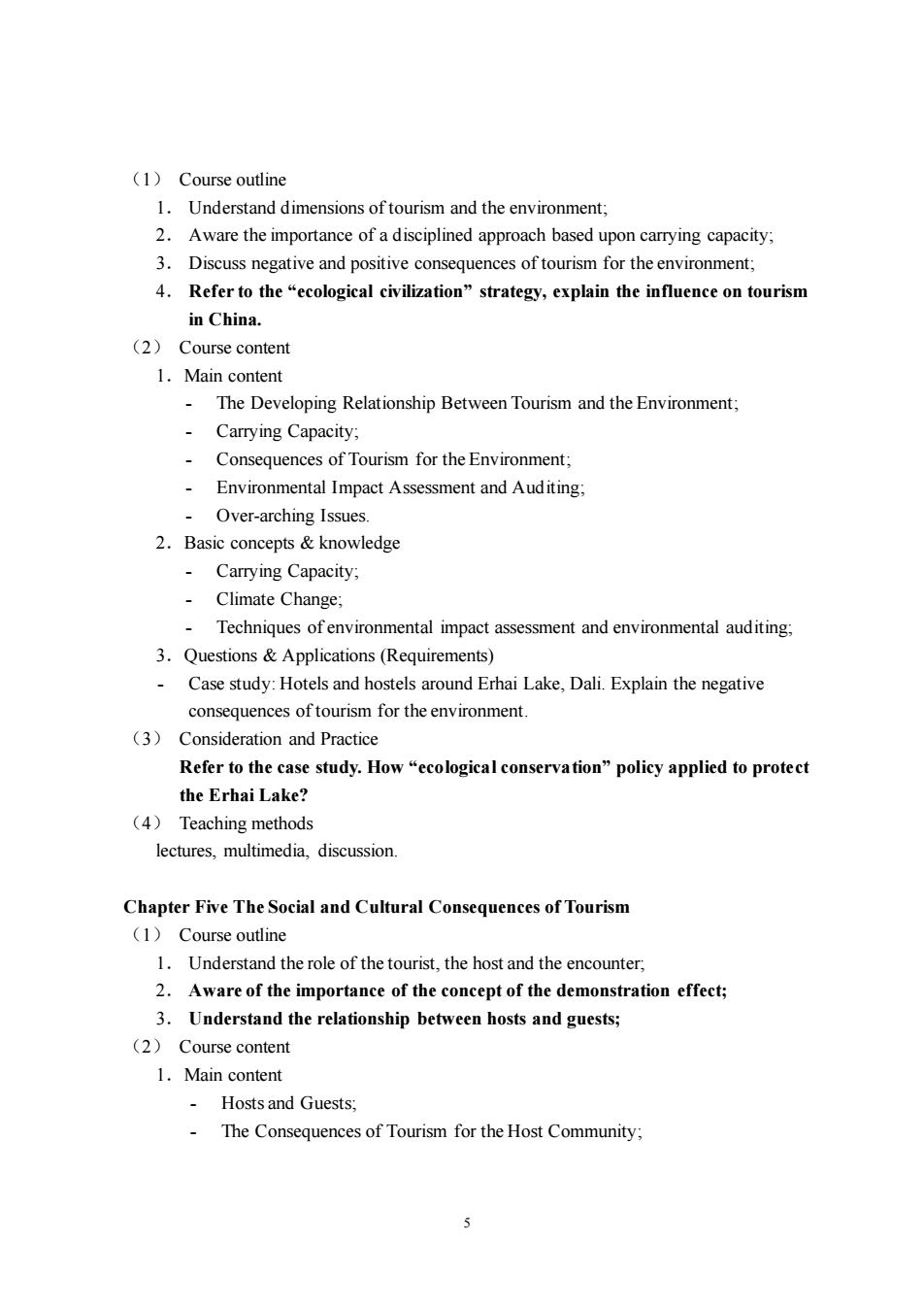
(1)Course outline 1.Understand dimensions of tourism and the environment; 2.Aware the importance of a disciplined approach based upon carrying capacity; 3.Discuss negative and positive consequences of tourism for the environment: 4.Refer to the "ecological civilization"strategy,explain the influence on tourism in China. (2)Course content 1.Main content The Developing Relationship Between Tourism and the Environment: Carrying Capacity; - Consequences of Tourism for the Environment Environmental Impact Assessment and Auditing; Over-arching Issues 2.Basic concepts knowledge Carrying Capacity Climate Change; Techniques ofenvironmental impact assessment and environmental auditing: 3.Questions &Applications(Requirements) Case study:Hotels and hostels around Erhai Lake,Dali.Explain the negative consequences of tourism for the environment. (3)Consideration and Practice Refer to the case study.How "ecological conservation"policy applied to protect the Erhai Lake? (4)Teaching methods lectures,multimedia,discussion. Chapter Five The Social and Cultural Consequences of Tourism (1)Course outline 1.Understand the role of the tourist,the host and the encounter. 2.Aware of the importance of the concept of the demonstration effect; 3.Understand the relationship between hosts and guests; (2)Course content 1.Main content Hosts and Guests; The Consequences of Tourism for the Host Community;
5 (1) Course outline 1. Understand dimensions of tourism and the environment; 2. Aware the importance of a disciplined approach based upon carrying capacity; 3. Discuss negative and positive consequences of tourism for the environment; 4. Refer to the “ecological civilization” strategy, explain the influence on tourism in China. (2) Course content 1.Main content - The Developing Relationship Between Tourism and the Environment; - Carrying Capacity; - Consequences of Tourism for the Environment; - Environmental Impact Assessment and Auditing; - Over-arching Issues. 2.Basic concepts & knowledge - Carrying Capacity; - Climate Change; - Techniques of environmental impact assessment and environmental auditing; 3.Questions & Applications (Requirements) - Case study: Hotels and hostels around Erhai Lake, Dali. Explain the negative consequences of tourism for the environment. (3) Consideration and Practice Refer to the case study. How “ecological conservation” policy applied to protect the Erhai Lake? (4) Teaching methods lectures, multimedia, discussion. Chapter Five The Social and Cultural Consequences of Tourism (1) Course outline 1. Understand the role of the tourist, the host and the encounter; 2. Aware of the importance of the concept of the demonstration effect; 3. Understand the relationship between hosts and guests; (2) Course content 1.Main content - Hosts and Guests; - The Consequences of Tourism for the Host Community;